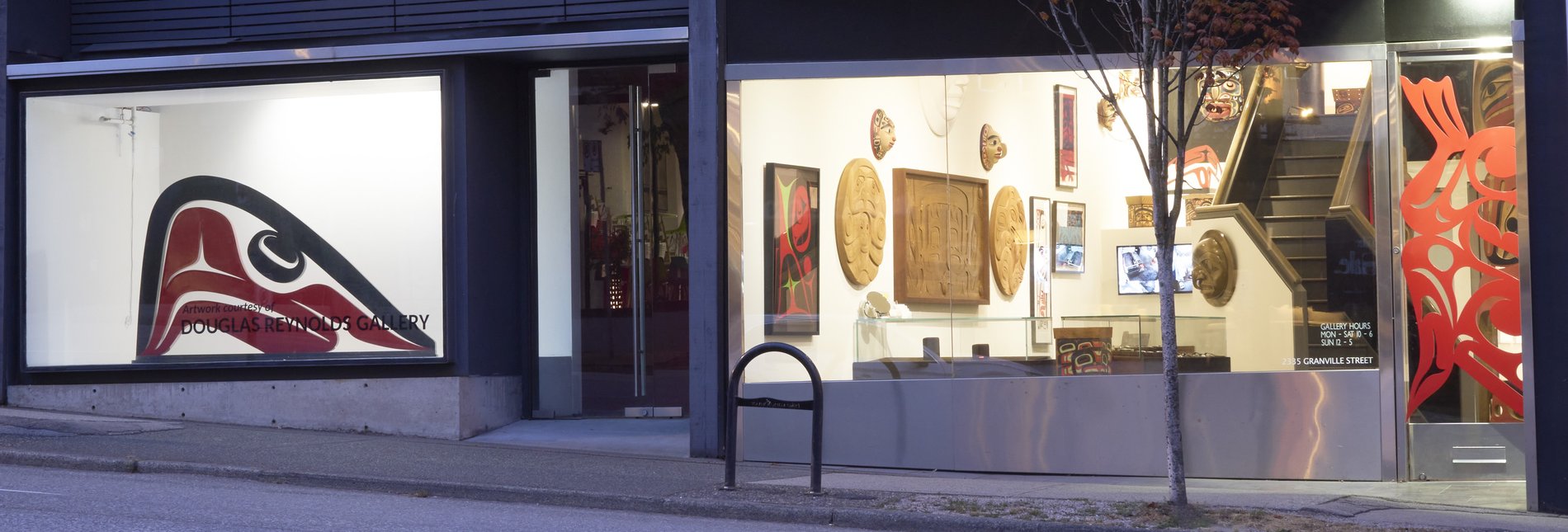It appears that your cart is currently empty
PANELS OF THE NORTHWEST COAST

HISTORIC BEGINNINGS
FEATURED ARTWORK



A Second Look at Asymmetry
Robert Davidson (Haida)
Red Cedar, Acrylic
60″ L x 35″ W x 2″ D
This abstract formline panel is simple, refined and balanced. It is free from crests and figures and your eye is drawn to the details and finesse of the carving. Robert Davidson’s skill is represented in his seamless execution of three angles of carving: perpendicular (the relief on the red edges), undercutting (the contact of the red edges with the background) and sloped (blue edges). The design of this panel, like his more recent paintings, follow this exploration into abstraction.
…innovation comes from a great depth of knowledge. So I feel that in order for me to do what I am doing today, I needed to go through all that studying the old masters…Through all that practicing I feel very comfortable in the direction that I am going in because I feel that I have really studied the old masters.
– Robert Davidson, May 2015
YELLOW and RED CEDAR

Killer Whale Panel
Don Yeomans (Haida)
Yellow Cedar
36” diam x 2″ D

Wolf Panel
Alano Edzerza (Tahltan)
Red Cedar
56″ diam x 2″ D

Embryonic Eagle
Robert Mills (Tlingit)
Red Cedar
36” diam

Eagle and Butterfly Panel
Roger Smith (Haida)
Yellow Cedar, Acrylic
35″ diam x 1¾” D
An unpainted panel draws attention to the lines of a carving and the methods used to create each crest. Like silver and gold bracelets, carving an unpainted panel leaves artists to use the angle of the cuts of the wood to create the formline design rather than the use of paint. All crest designs will be composed of uncarved surfaces and carved depressions acting in tandem. Some artists will incorporate deep gouging to border their figures (Wolf Panel, above), while other artists incorporate stippling to add another “colour” or textual component to a panel (Killer Whale Panel, above).

Raven Moon Panel
Jim Charlie (Salish)
Red Cedar, Acrylic
33″ diam x 1½” D

Thunderbird Panel
Jim Charlie (Salish)
Red Cedar, Acrylic
33″ diam x 1¾” D
PERSPECTIVE

This image is of the modern constructed village at K’san. The painted surface is an artwork in its own right but the monumental scale of these house fronts allows the art to become the background for daily life. Superimposing images onto backgrounds can be seen in some panels to create an element of perspective.

Sisiutl Panel
Rande Cook (Kwakwaka’wakw)
Red Cedar
75″ W x 52″ H x 2″ D

Spirit Bear Family
Bradley Hunt (Heiltsuk)
Red Cedar, Copper, Acrylic
32″ H x 48″ W x 2″ D

Wasco Panel
Doug Zilkie (Non-Indigenous)
Red Cedar, Acrylic
57″ H x 48″ W x 2″ D

Held in Mindfulness
Terry Jackson (Metis)
Red Cedar, Acrylic
34″ H x 26″ W x 2″ D
Forton
Forton is a resin metal composite that is increasingly being used in the art world as an alternative to bronze to create cast editions. For panels and other large scale works especially, forton offers artists the ability to create editions that can hold a patina, like bronze or steel, but with a fraction of the cost and a substantial reduction in the weight.

Sea Bear
Don Yeomans (Haida)
Cast Forton, Pewter Patina
78″ diam x 16″ D

Octopus and Killer Whale
Don Yeomans (Haida)
Cast Forton, Pewter patina
36″ diam x 2″ W

Seal & Salmon
Phil Gray (Tsimshian)
Cast Forton, Marble patina
36” diam x 1½” D

Raven and First Men
Ben Davidson (Haida)
Cast Forton, Rust patina
48″ diam

Wolf Panel
Alano Edzerza (Tahltan)
Forton, Pewter patina
55″ diam x 1¾” D
Panels Under $1000
To compete against the price of framed prints many artists are creating panels and often framing them. These are original art pieces but priced similar to many smaller prints.

Thunderbird Panel
Jazmine McCrimmon-Cook (Kwakwaka’wakw)
Red Cedar, Acrylic
12″ diam x 1½” D

Thunderbird Panel
Jazmine McCrimmon-Cook (Kwakwaka’wakw)
Red Cedar, Acrylic
24″ diam x 1½” D

Raven Panel
Jim Charlie (Salish)
Yellow Cedar, Acrylic
17″ L x 10″ W x 1½” D

Raven Panel
Jim Charlie (Salish)
Yellow Cedar, Acrylic
18½” L x 13″ W x 1½” D

Raven and the Light Panel
Cecilia Adams-Dangeli (Gitxsan)
Yellow Cedar, Acrylic
17½” L x 11″ W x 2″ D

Speaking With Someone
Blake Lepine (Tlingit)
Laminate Flooring, Acrylic, Akoya
15″ H x 18″ W x 1½” D

Killer Whale Panel
Jim Charlie (Salish)
Yellow Cedar, Acrylic
22″ L x 12½” W x 1½” D

Eagle Panel
Jim Charlie (Salish)
Yellow Cedar & Acrylic
23″ W x 10½” H x 2″ D

Salmon Panel
Jim Charlie (Salish)
Yellow Cedar, Acrylic
24″ L x 7½” W

Mouse Woman Panel
Jim Charlie (Salish)
Yellow Cedar, Acrylic
24″ L x 10″ W


0 comments